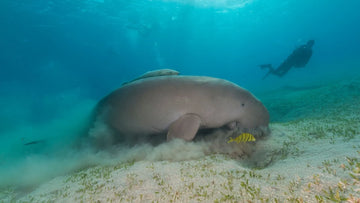The presence of liveaboard in the southern Red Sea has grown enormously, but it is still not as crowded as the north, and the more experienced divers now head straight south, mainly to the dive sites of Marsa Alam. Excursions are not as comfortable as in the north, with long boat and bus rides, but the trip is worth it when you come face to face with oceanic whitetip sharks, dugongs, schools of hammerhead sharks, pods of dolphins or extraordinary coral reefs teeming with colorful life.
By the way, remember for Red Sea enthusiasts, its diving spots, and fauna, we have a unique and extra original collection of T-shirts inspired by the Red Sea :-)
One of the main attractions of diving in the southern Red Sea is the chance to see oceanic whitetip or longimanus sharks, and this is probably the best area in the world to see them. This predator, often listed as one of the most dangerous fish in the ocean, prefers waters away from coral reefs, but Marsa Alam and its deep waters provide an ideal environment for them. Other sharks regularly seen here include thresher sharks, as well as a variety of reef sharks such as grays and white tips, and less commonly whale sharks and manta rays.
Encounters with large predators would be reason enough to recommend this area for your Red Sea diving trip, but you should also know that the coral systems in the south are healthier and have more vibrant life than in the north. Small dwellers such as butterfly fish, antias or nudibranchs as well as large humphead wrasse, tuna or giant parrotfish are perfectly represented at almost all dive sites in Marsa Alam.
______________________
The best liveaboard offers in the Red Sea
______________________

Oceanic whitetips are one of the main diving attractions in the southern Red Sea
Most of the diving in this area is along the deep walls, but some southern areas offer interesting reefs sheltered from the currents, where diving is easier, and even some interesting wrecks. However, it should be noted that the Red Sea south of Hurghada is subject to strong currents and only those with the necessary skills and experience will be able to get to know Marsa Alam thoroughly.
Oceanic whitetips can be seen from May to June in St. John's and from October to the end of the year in Elphinstone. Thresher shark season runs from fall through winter around Brother Islands and Daedalus. Hammerheads can be seen at Daedalus in the summer, and spring is the time when manta rays and whale sharks visit the southern Red Sea, especially St. John's, Brother Islands and Daedalus Reef.
Main diving spots in Marsa Alam
Abu Dabab
Abu Dabbab perfectly symbolizes the term coral garden. The six reefs that make up this point have extraordinary corals teeming with colorful life. But one of the most important aspects of this reef is the presence of such incredible residents as dugongs, "sea cows" that spend the day grazing on the bottom, and huge green turtles with their inseparable remoras. An easy dive site that is highly recommended. Yes, we also have a T-shirt dedicated to one of the most famous dugongs in the Red Sea, Dennis XD.
Dolphin House (Sha'ab Samadai Reef)
Dolphin House, also known as Sha'ab Samadai Reef, is a crescent-shaped reef that has become home to dozens, if not hundreds, of dolphins that you can swim with while snorkeling. From 20 to 300 dolphins are spotted daily in this area, a unique spectacle in one of the most famous areas of Marsa Alam.
Daedalus Reef
This isolated reef is one of the best places in the Red Sea not only to see the big predators in action, but also to enjoy the magnificent coral covered walls and reef fish. It would be worth a visit just for the schools of hammerheads, longimanus or whale sharks, but it has so much more to offer!
Elphinstone
Elphinstone is probably one of the most famous reefs not only in the southern Red Sea but in the entire Red Sea. Both for the possibility of seeing Whale Sharks, Longimanus, Grey or Hammerhead Sharks and for its beautiful and vertiginous walls covered with bright corals make this reef the most sought after by divers who venture to dive in the south.
Brother Islands
The Brother Islands are two islands that seem to be two magnets for pelagics. This national park is exceptional for diving with sharks, especially threshers and hammerheads, but also for coral colonies of exceptional quality, thanks to its strong and nourishing currents, which host the typical fauna of the Red Sea. As if that were not enough, these islands hide two very interesting surprises: the wrecks of Numidia and Aida.





















